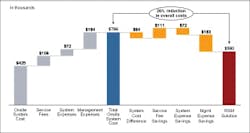Software as a Service (SaaS) has been around for years but not until recently did it take hold in areas beyond banking or Customer Relationship Management (CRM) tools to encompass physical security. Customers are now trusting SaaS systems as much, if not more, than their own IT systems. With the help of good providers using separate disaster recovery centers to restore full operations and the Internet's capability to send information using various routes, customers now have the peace of mind and redundancy they need if their primary center becomes disabled. As the comfort levels of using SaaS increase, growth in its adoption is sure to follow.
Worldwide SaaS revenue is forecasted to reach $12.1 billion in 2011, a 20.7 percent increase from 2010 revenue of $10 billion, according to Gartner Inc., Stamford, Conn. More and more integrators, drawn by the allure of Recurring Monthly Revenue (RMR), are embracing the SaaS model. Traditionally, integrators depended on project and/or service business to achieve financial success. While profitable for many integrators, this business model is dependent on managing and maintaining physical resources for execution, i.e., tied to hardware sales, which have plunged in yielding substantial profitability.
Portfolio adoption is critical
Integrators can add SaaS to their portfolio in two ways-they can host solutions themselves or sign up with a third-party hosting provider. For new SaaS providers, the better approach might be to start off with the latter, turning to a third-party hosting provider until they reach a critical mass in number of subscribers. They can then move to an in-house solution once the organization attains the IT expertise and required infrastructure.
With SaaS, the integrator receives an RMR stream that is sustainable, while SaaS solutions provide customers with a more affordable way to implement the security they need. This flexible, Web-based solution minimizes a company's upfront capital costs and reduces IT expenses. Chief Security Officers (CSOs) can execute new security capabilities without investing in the technology and human resources required to support the service. Since the SaaS model is based on constant technological updates supported by monthly fees, customers do not have to worry about additional costs for maintenance or hardware. They can also treat it as an ongoing operational expense, better for the bottom line and less prohibitive than a large capital outlay of cash.
Enterprise-class customers pose challenge
Initially, small to medium-sized customers moved into the cloud due to lack of resources and capital. SaaS provides them with a viable, cost-effective alternative that meets their growing security needs. However, the challenges to SaaS do not typically come from the small to medium-sized companies, but from the large enterprise-class customers. These customers may currently be struggling to answer not only 'how' SaaS solutions can help them but 'if' they can accomplish it as well.
The answer calls for a more robust solution than just SaaS alone. It should be combined with managed services such as Remote Access Management (RAM) and remote video monitoring services. Through this combination of hosted and managed services, enterprise customers are likely to reduce their upfront capital costs and further reduce the solution's total cost of ownership by cutting their IT and security spending over time.
Despite the initial questions and challenges that SaaS may pose, systems integrators can help end-users bask in the benefits and at the same time, grow their company's revenue streams to another level-creating a win-win for all.
SaaS Scenario's Explored
When considering SaaS, it is important to know which model is right for you. Following is an example of how Siemens helps customers compare the cost of a typical onsite system versus a Remote Security Management (RSM) solution comprised of hosted and managed services.
Together, Siemens and its customer enter relevant data into the total cost of ownership tool. Once this is accomplished and the analysis has been run, we look at the cost of the onsite system in terms of up-front system and ongoing service costs, as well as IT system and management expenses. Over a three-year period, those costs can add up. Siemens' analysis dissects the onsite system costs and compares them to the RSM solution to reveal where the cost savings occur. The upfront system expenses are reduced because there is less IT equipment required to install onsite. Services fees, however, will increase due to the costs of hosting and managing the system from the provider. On the other hand, management costs are eliminated because the remote security management team now conducts those activities. In the end, the customer has a financial argument that they helped create to justify their case to move to the cloud.

